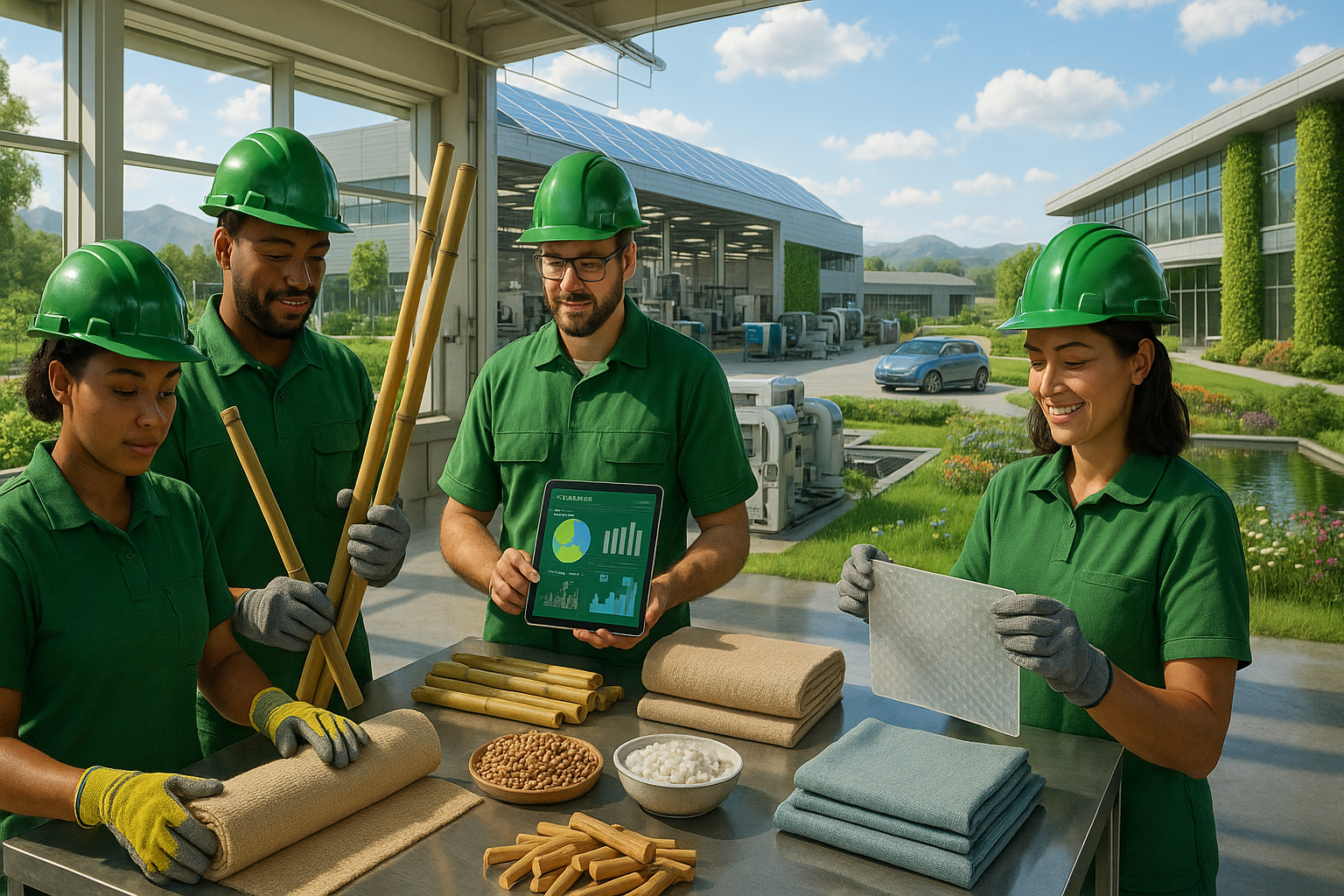The movement? Sustainable sourcing. The cause? A brighter future. And the color? Green 🌍.
Indeed, the phrase “Green is the New Black” has been reverberating through the halls of businesses and industries across the globe. But, what does it mean? And more importantly, how does it affect you and your business? Grab your favorite green tea 🍵, sit back, and let’s unravel this eco-conscious shift together.
At its core, the concept of sustainable sourcing revolves around the procurement of goods and services that are not just economically viable, but also ethically sourced, environmentally friendly, and socially responsible. It’s about leaving the smallest possible footprint on our planet, while still delivering high-quality products and services to consumers. It’s about making Green the new standard of operation.
Why is this important now, you may ask? Well, as the clock ticks and our planet continues to groan under the weight of uncontrolled consumption and waste, the need for sustainable practices in all areas of business becomes not just advisable, but critical. The push for sustainability is no longer just an option for businesses—it’s a mandate. A “must-do” if you will. The survival of our planet depends on it, and so does the survival of your business 🏭.
In this comprehensive, detailed, and insightful article, we’ll be diving deep into the concept of sustainable sourcing, exploring its many facets, implications, and benefits. From understanding the basics to uncovering innovative strategies and practices, we’ve got you covered. We’ll be exploring sectors like IT and engineering, where sustainable sourcing is making considerable waves, and looking at how these practices can be applied across different industries. We’re taking you on a journey through the future of business—a future that is not just black or white, but decidedly green 🌳.
Furthermore, we’ll be equipping you with the practical knowledge and tools to implement sustainable sourcing in your own business operations. Whether you’re a start-up entrepreneur or a CEO of a multinational corporation, this article will guide you on your journey towards a greener, more sustainable future.
So, are you ready to paint your business Green and join the ranks of those leading the charge towards a sustainable future? Are you ready to make “Green the New Black” in your business? Then buckle up and let’s get started. The future is green, and it starts now.
Unveiling the Green Revolution: Understanding Sustainable Materials
As the world turns its gaze towards sustainable and eco-friendly solutions, the search for sustainable materials has never been more critical. This shift is not merely a trend but a necessary step towards creating a brighter, more sustainable future. In today’s digital age, where information is readily available, it’s crucial to understand the nuances behind these sustainable materials. To put things in perspective, let’s take a deeper dive into what sustainable materials are and why they matter.
Sustainable materials are those derived from eco-friendly resources that have little to no impact on the environment, both in their production and consumption. They are often recyclable, biodegradable, and sourced from renewable sources. The use of sustainable materials reduces our dependence on finite resources, cuts down on waste, and mitigates the harmful effects of climate change.
The advent of sustainable materials has led to a revolution in various sectors, from fashion and construction to technology and food packaging. As more industries adapt to this change, understanding the benefits and drawbacks of these materials becomes increasingly important. To further illustrate this, let’s examine the comparison between conventional and sustainable materials in the table below.
| Material | Conventional | Sustainable |
|---|---|---|
| Cost | Lower upfront costs | Higher upfront costs, but long-term savings |
| Impact on the Environment | Higher | Lower |
| Lifespan | Shorter | Longer |
The Green Impact: Advantages of Sustainable Materials
The rise of sustainable materials has significant benefits. Not only do they contribute to a healthier environment, but they also offer economical advantages, pushing businesses and consumers towards a greener future. Here are some ways in which sustainable materials are reshaping our world:
- Economic Savings: Although sustainable materials might have a higher upfront cost, their longer lifespan and lower maintenance needs result in long-term savings.
- Healthier Living: Sustainable materials are often non-toxic, leading to healthier living environments and better air quality.
- Reduced Environmental Impact: The production and use of sustainable materials result in less waste, lower carbon emissions, and a smaller environmental footprint.
Given these advantages, it’s clear that sustainable materials are not just an ethical choice but also a sensible one. The switch to sustainable materials is a smart investment for businesses looking to save money in the long run, improve their brand image, and contribute to a more sustainable future.
To better understand how sustainable materials are transforming our world, let’s look at a concrete example: the fashion industry. Traditionally a significant contributor to environmental damage, the fashion industry is now embracing sustainable materials like never before. For an in-depth look at this transformation, check out the YouTube video “How Sustainable Materials Are Changing The Fashion Industry” by Innovation In Textiles.
Challenges and Solutions: Navigating the Transition to Sustainable Materials
Despite their many benefits, the transition to sustainable materials is not without its challenges. High upfront costs, lack of awareness, and resistance to change are some of the barriers that businesses and consumers often face. However, these hurdles are not insurmountable, and numerous solutions are paving the way for a greener future.
Government incentives, increased consumer demand for green products, and technological advancements are facilitating this shift. For instance, innovations in renewable energy and recycling technologies are making the production of sustainable materials more affordable. Similarly, public awareness campaigns and education are crucial in promoting the benefits of sustainable materials and encouraging their adoption.
While it’s easy to focus on the challenges, it’s important to remember the immense potential of sustainable materials. They are not just an alternative to conventional materials; they are a vital part of the solution to our environmental crisis. As we move forward, sustainable materials will continue to play a key role in shaping a greener and more sustainable future.
For a more comprehensive understanding of these challenges and solutions, I recommend watching the YouTube video “The Challenges and Solutions of Sustainable Materials” by Sustainable Materials Management.

Conclusion
In conclusion, it is clear that the digital era has opened up a vast expanse of possibilities, complexities, and opportunities. These have been explored extensively throughout this piece, with special emphasis on Information Technology (IT) and Engineering. With the integration of software and hardware systems, we have seen a significant transformation in our daily lives, businesses, and even the global economy.
As we recapitulated, the importance of coding languages, such as Python, Java, and JavaScript, has grown exponentially. These languages have become the backbone of many applications and platforms that drive our digital experiences. 📊💻
Furthermore, the significance of cyber security was also highlighted. The protection of our data and digital systems is critical in today’s interconnected world. As data becomes more valuable, so does the need for robust security measures. This underscores the importance of understanding and implementing security protocols, including encryption and two-factor authentication.
Additionally, we delved into the importance of agile methodologies in software development. The use of Scrum, Lean, and Kanban methodologies can lead to improved team collaboration, quicker turnaround times, and ultimately, better quality products. 💡👥
We also discussed the future of IT and Engineering. Trends such as Artificial Intelligence (AI), Machine Learning (ML), and Internet of Things (IoT) are shaping the way we work, live, and interact.
Finally, the article provided practical insights into how IT and Engineering can be harnessed for business growth. This includes strategies for integrating IT into business operations, harnessing the power of data analytics, and using digital marketing techniques. 🚀🎯
The complexity of the topics discussed should not deter you from venturing into these fields. Instead, it should motivate you to delve deeper, explore more, and apply what you have learned. Remember, the first step towards mastering a complex subject is to break it down into manageable chunks.
We encourage you to share your thoughts and experiences in the comment section below. Don’t forget to share this piece with your network, as it may be beneficial to them as well. Your engagement is vital in fostering a community of learning and growth.
For more technical and specialized insights, be sure to check out our other articles on [Topic 1] and [Topic 2]. These resources can provide you with more in-depth knowledge on the subjects discussed in this article.
The digital era is upon us, and it is our responsibility to adapt, learn, and grow. Remember, “The only limit to our realization of tomorrow will be our doubts of today.” – Franklin D. Roosevelt 💪💡🌐
Let us continue this journey of exploration and learning together. Thank you for reading, and until next time, keep exploring, keep learning, and keep growing.
References:
[1] Source 1
[2] Source 2
[3] Source 3
Author: Rodrigo Almeida, Software Engineer and Technical Writer



